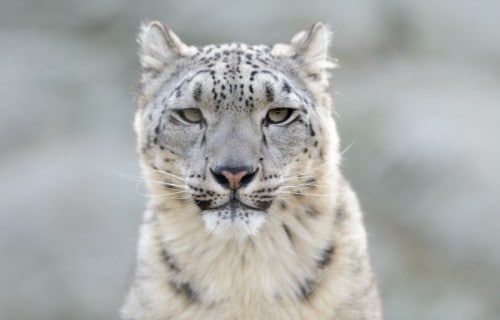
7 Truly Breathtaking Mammals
We present to you our choice for a list of 7 Truly Breathtaking Mammals. Of course, any such list remains entirely subjective. Animals that we consider deserving of inclusion on this list might not agree with your own thoughts on the matter. Certainly, the sheer number of animal species existing in this beautiful world of ours, combined with the number of humans coexisting with them, makes such an event unavoidable.
Yet, any such listing obviously has to begin somewhere. If you have thoughts of other species you feel worthy of inclusion on such a list, please send us your thoughts. We welcome them, of course. Who knows, you might know of a creature we don’t (which certainly happens), and end up giving us a wonderful and exciting new topic to create an article about.
In that way, you yourselves, our readers, can help the rest of our readers enjoy the wonders of our world even better. For now, we hope you enjoy our list of 7 Truly Breathtaking Mammals.
Tree Kangaroo
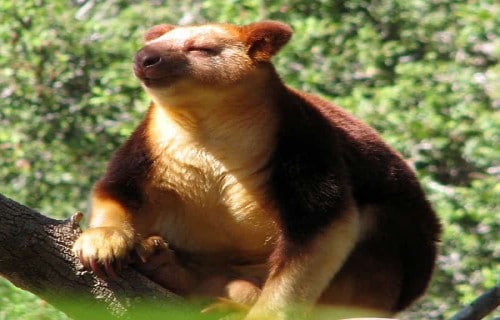
Tree Kangaroo Facts
- The gorgeous Tree Kangaroo represents a unique genus of kangaroo. This remarkable animal actually evolved into a primarily arboreal creature.
- The majority of known members in this incredible genus remain considered to be threatened with extinction. The principal reasons for this include habitat loss and hunting.
- Individuals typically remain very slow and clumsy on the ground. It moves rather slowly, haltingly, and hops awkwardly. Yet in the trees, it actually appears to be extremely agile and a surprisingly effective climber.
- This surprising creature also ranks as an amazingly powerful leaper. It has been seen to jump as much as 30 ft (9 m) from one limb to another.
- It can also jump to the ground from as high as 59 ft (18 m) without any injury. This ranks as absolutely incredible.

Tree Kangaroo Physical Description
The astonishing Tree Kangaroo has evolved several adaptations useful for an arboreal life. Its back legs grow much broader and shorter than those of its terrestrial cousins.
It also possesses rather long, curved nails on those rear legs, which the gorgeous mammal routinely, and quite effectively, uses for gripping and climbing.
The Tree Kangaroo also has a much broader and longer tail than a terrestrial kangaroo. This provides it with an enhanced balance while moving through the canopy.
Like terrestrial kangaroos, it remains physically incapable of sweating, to cool its body. Instead, it licks its forearms and allows the moisture to evaporate. Take a moment to imagine if humans did this.
Kingdom: Animalia
Phylum: Chordata
Class: Mammalia
Order: Diprotodontia
Family: Macropodidae
Genus: Dendrolagus

Tree Kangaroo Distribution, Habitat, and Ecology
The only known forms of the surprising Tree Kangaroo inhabit the rainforest regions of New Guinea, parts of Queensland, Australia, and a few local islands.
The majority of the different species in the genus live in montane areas. There remain several that dwell in lowland areas, however.
This stunning animal thrives in treetops, as opposed to terrestrial kangaroos which inhabit mainland Australia. It has somehow managed to adapt better to regions of high altitude than its terrestrial cousins.
It breeds during the monsoon season. Tree Kangaroo matings produce only one young per litter. Its primary predator seems to be the amethystine python, which also inhabits the same canopies.
Being herbivorous in nature, its own diet consists principally of fruits and leaves.
Pangolin
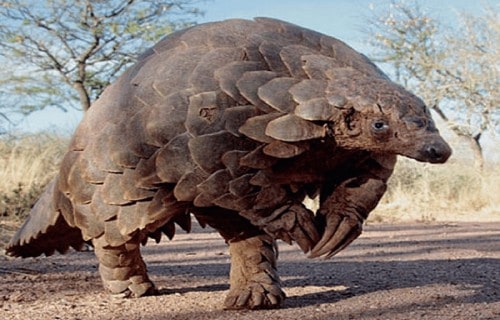
Pangolin Facts
- The Pangolin remains the only known mammal to have evolved protective scales. Due to these, people sometimes call it the scaly anteater.
- The animal constitutes the only surviving member of a family. Also, only four known species of this unique creature exist.
- Sadly, this impressive species now lists as Critically Endangered by the IUCN. The Pangolin remains the most heavily hunted mammal in the world.
- It now enjoys protection by law, yet illegal hunting continues. It still gets hunted both as a source of bushmeat and for their scales (for clothing). Sadly, people also hunt it for use in making traditional medicines.

Pangolin Physical Description
Due to its distinctive appearance, the Pangolin remains easily recognizable.
The scales covering its body grow large, and composed of keratin. Each scale also possesses a sharp edge, further increasing the protection they provide. These protect the Pangolin from would-be predators since the animal curls into a tight ball when threatened.
The various species range in length from 12-39 in (30-100 cm). An average weight is approximately 4.4 lb (2 kg). Sexual dimorphism is present, with males averaging 50% larger than females. Their legs grow short, giving it a low-slung form. It also possesses a thin tongue which they can extend as much as 16 in (40 cm).
The claws are relatively long and quite powerful. In addition to its armor, it has a second defense mechanism. When threatened, it can release a noxious-smelling chemical from glands near the base of its tail.
Kingdom: Animalia
Phylum: Chordata
Class: Mammalia
Order: Pholid0ta
Family: Manidae

Pangolin Distribution, Habitat, and Ecology
The Pangolin evolved as endemic to parts of both Asia and Africa. It inhabits either grasslands or forests within that range.
The majority of the different species live as nocturnal, yet one appears active by day. It typically makes its homes in either hollow trees or deep burrows. These burrows may be as much as 11 ft (3.5 m) deep.
Its diet consists mainly of termites and ants, which it locates with its keen sense of smell. These it extracts with its specially adapted tongues.
This extraordinary creature typically walks on all four legs, yet remains capable of walking on its rear legs only for a short time. It also seems to be an excellent swimmer.
This animal lives a primarily solitary life, usually meeting only to mate. A typical litter contains 1-3 offspring.
Lowland Streaked Tenrec

Lowland Streaked Tenrec Facts
- The bizarre-looking Lowland Streaked Tenrec forms an extraordinarily unique species of Tenrec. The species has developed several completely unique attributes.
- Remarkably, it remains the only known mammal to generate sound by stridulation. Mothers use this as a means of communicating with their young.
- Also, it serves as the only known species of tenrec to be active by both day and night. All other tenrecs only become active at night. This serves to give them a competitive edge.
- Lastly, this ranks as the only known tenrec to live in groups. It also tends to remain with its family, living in groups of as many as twenty individuals.
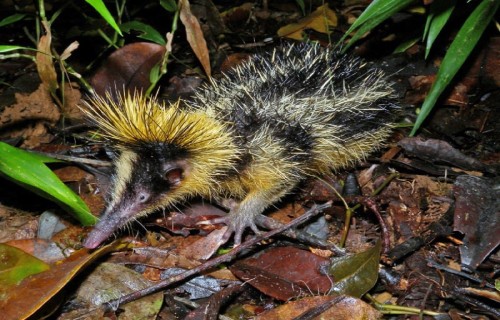
Lowland Streaked Tenrec Physical Description
The Lowland Streaked Tenrec forms a rather diminutive animal. Mature adults attain an average length of head and body of approximately 6.5 in (16.5 cm). It also stays quite light, rarely exceeding 7 oz (200 grams) in weight.
Its snout grows rather elongated, while the tail appears vestigial. The head, back, and sides appear black, with long yellow stripes. The underbelly typically displays a chestnut brown and covered with soft fur.
Yet the rest of the body is covered with numerous long, sharp quills. It is also important to note that some of these develop as barbed and detachable, and used in defense.
In fact, these seem most numerous on the crown of the head. Also, it is the remarkable quills that are used for stridulation.
The Lowland Streaked Tenrec rubs these together to generate a unique sound. This sound is so low-pitched that it is below the threshold of human hearing.
Kingdom: Animalia
Phylum: Chordata
Class: Mammalia
Order: Afrosoricida
Family: Tenricidae
Genus: Hemicentetes
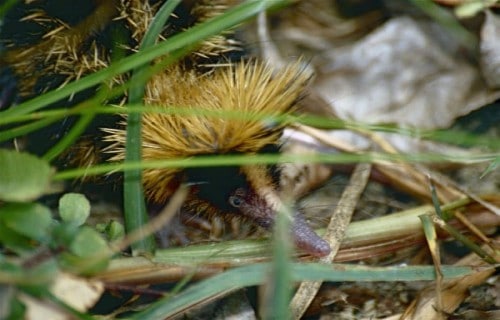
Lowland Streaked Tenrec Distribution, Habitat, and Ecology
The Lowland Streaked Tenrec inhabits a rather limited range. The species is found throughout less than half of the island of Madagascar, near Africa. Its range consists almost entirely of lowland (hence the name) tropical rainforest.
Consequently, in the loose soil, it typically constructs long, shallow burrows in which to dwell. These are also rarely more than 6 in (15 cm) beneath the surface.
The species is primarily insectivorous, but will also consume worms and fruit.
Its principal predators include the Fossa and the Malagasy Mongoose. Attacking the nose and paws of a predator with the quills is its only defensive strategy.
Breeding usually occurs between October and December. An average litter consists of 5-8 young.
Sadly, their lifespan is short, averaging less than 2.5 years.
Kashmir Musk Deer

Kashmir Musk Deer Facts
- The Kashmir Musk Deer remains a rather highly reclusive species of deer. Believed to be extinct until 2008, this rather unique animal had not been seen for more than sixty years prior to that.
- The IUCN lists the Kashmir Musk Deer as Critically Endangered.
- Due to its reclusive nature and the ruggedness of its native terrain, it currently remains impossible to estimate its actual numbers, however.
- The major threats to its existence seem to be habitat loss and local hunting.
- In a pitiful commentary on the nature of some human beings, poachers also hunt the amazing creature solely for its scent glands.

Kashmir Musk Deer Physical Description
The most distinctive physical characteristic of the relatively diminutive Kashmir Musk Deer remains its development of two small tusks. These it uses during the mating season to compete for females.
The species displays sexual dimorphism in this regard. Only the males develop the unique tusks.
The animal averages approximately 24 in (60 cm) in height at the shoulder.
The coloring primarily seems to be a random mottling of brown, gray, and black.
Its precise lifespan remains undetermined but is believed to be approximately seven years.
Kingdom: Animalia
Phylum: Chordata
Class: Mammalia
Order: Artiodactyla
Family: Moschidae
Genus: Moschus
Species: M. cupreus

Kashmir Musk Deer Distribution, Habitat, and Ecology
The remarkable Kashmir Musk Deer was originally endemic to portions of Pakistan, India, and Afghanistan, in Asia. Since 2008, observers have spotted a total of only three different individuals in the wild.
Also, all three individuals appeared on the extremely steep and rugged northeastern slopes of Afghanistan. This further complicates efforts to study them.
The species also has a herbivorous diet in nature and seems to be principally crepuscular. It appears to feed primarily on a combination of grass, leaves, shrubs, and lichen.
Its precise lifespan also remains undetermined but experts believe it to be approximately seven years.
Okapi

Okapi Facts
- The Okapi appears on most lists as the 9th rarest creature on Earth. It inhabits only the most isolated and remote areas of the Ituri Rainforest, in the Congo.
- Many experts consider it to be a living fossil since it has no known closely related species.
- Genetically, it represents an extremely distant relative of the giraffe, despite its zebra-like markings. Official estimates place their remaining numbers at fewer than 20,000 individuals.

Okapi Physical Description
The distinctive looking Okapi stands roughly 4.9 ft (1.5 m) tall at its shoulder. Being genetically related to the giraffe, it also possesses a comparatively long neck. An average body length measures 8.2 ft (2.5 m), although larger individuals do occur.
Depending on specific individual habitats and diet, adult weights vary between 440 – 770 lb (200 – 350 kg).
The coat generally presents as either a reddish or chocolate brown color. But the most remarkable feature remains the white horizontal stripes appearing on its legs.
The creature also develops an extremely long, generally purple, tongue. This averages roughly 18 in (45.7 cm) in length.
Its chest, throat, and face generally display a greyish white. In addition, males display very small horns called ossicones.
This remarkable mammal does display sexual dimorphism, but only to a small degree. The females average roughly 1.7 in (4.2 cm) greater in height and lack the tiny horns.
Kingdom: Animalia
Phylum: Chordata
Class: Mammalia
Order: Artiodactyla
Family: Giraffidae
Genus: Okapi
Species: O. johnstoni

Okapi Diet, Distribution, and Habitat
The astonishing Okapi has an entirely herbivorous diet. This consists primarily of grass, buds, leaves, ferns, fungi, and various fruits. It remains unique within its habitat as the only mammal that feeds exclusively on understory vegetation.
The species only exists in the Democratic Republic of the Congo, in Africa. There, it only appears in canopy forests at altitudes between 1,600 – 4,900 ft (500 – 1,500 m). It also occasionally utilizes areas that are seasonally inundated.
The only known populations appear in the northern, central, and eastern portions of the country. Furthermore, it only inhabits regions east and north of the Congo River.
Saiga Antelope

Saiga Antelope Facts
- The Saiga Antelope remains the most distinctive looking species of antelope in the world. This animal actually has a proboscis rather similar to a walrus.
- Sadly, the Saiga Antelope also holds the classification of critically endangered, according to the IUCN. This animal once inhabited an enormous portion of the Eurasian steppe.
- But now its population only inhabits portions of The Republic of Kalmykia, and Kazakhstan.
- Mankind hunted this incredible creature almost to the point of extinction in the 1920s. Fortunately, it managed to recover somewhat. Historically, hunting of the creatures occurred extensively among local populations.
- The greatest threats to its existence as a species remain a mysterious malady and extensive hunting for the procurement of its horn, which is used also in traditional Chinese medicines.
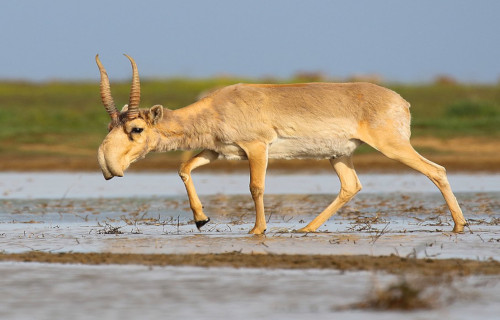
Saiga Antelope Physical Description
The most immediately noticeable feature of the Saiga Antelope is its unique proboscis. This is actually an over-sized nose structure which serves two purposes.
During migrations in the summer, it serves to filter out dust, and during the winter it heats up the frigid air before it enters the lungs. This represents a rather remarkable adaptation.
The animal displays a slight degree of sexual dimorphism, with the males being larger in size than the females. Additionally, the males develop moderately large, and uniquely colored horns, while the females are hornless.
Males may reach a height at the shoulder of as much as 2.5 ft (0.8 m), and weigh as much as 139 lb ( 63 kg). The antelope appears predominantly various shades of tan in color, except for the belly and throat. These typically display a white or cream color.
Kingdom: Animalia
Phylum: Chordata
Class: Mammalia
Order: Artiodactyla
Family: Bovidae
Genus: Saiga
Species: S. tatarica

Saiga Antelope Habitat, Behavior, and Ecology
The Saiga Antelope once inhabited a territory that extended from the foothills of the Carpathian Mountains all the way to what is now Mongolia.
Within its current range, the animal inhabits a variety of habitat types, including grasslands, steppes, woodlands, and semi-deserts. This species tends to form large herds, often numbering in the thousands.
It feeds on a variety of plants, including several species that are poisonous to other animals. It also engages in seasonal migrations that cover great distances.
Though adept at climbing, it tends to avoid extremely steep or rugged terrain. After the mating season, females actually come together in large groups to give birth. Interestingly, two-thirds of all births for this species consists of twins.

Saiga Antelope Mysterious Malady
In May of 2015, a terrible, and still mysterious, tragedy struck the already threatened Saiga Antelope population. Within a period of only 14 days, more than 130,000 of these unique creatures abruptly perished.
This number represents half of the world’s population of Saiga Antelope. Entire herds were extinguished in a matter of days.
The precise cause was never officially released. However, it is suspected that an extremely virulent form of pasteurellosis is responsible. Yet the underlying trigger of this apparent epidemic among this unique ungulate remains a complete mystery.
Narwhal
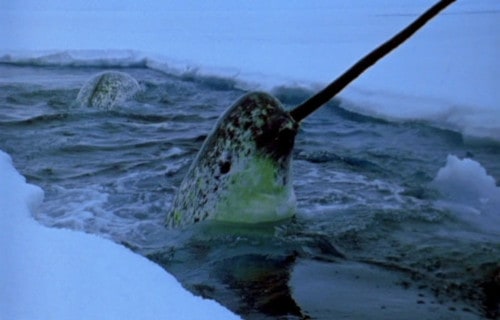
Narwhal Facts
- The rather remarkable Narwhal, Monodon monoceros, sometimes called the narwhale, ranks as a medium-sized toothed whale and the animal with the largest canines on the planet.
- The mammal grows to be a medium-sized whale, or around the same size as related species. Total length in both sexes, excluding the tusk of the male, can range from 13-18 ft. (4-5.5 m).
- Typical adult body weight measures between 1,800-3,500 lbs (800-1,600 kg).
- Males attain sexual maturity at 11 to 13 years of age, when they reach roughly 13 ft (4 m) in length, while females do so at 5 to 8 years old when they reach about 11 ft (3.3 m) long.

Narwhal Physical Description
The pigmentation of the Narwhal develops as a mottled pattern, with blackish-brown markings over a white background, unlike any other species of whale in any ocean.
The coloring of the creature appears darkest at birth, becoming whiter in color with age. White patches develop on the navel and genital slit at sexual maturity. Old males may be almost pure white.
Narwhals do not have a dorsal fin – possibly an evolutionary adaptation to swimming easily under ice. In addition, the neck vertebrae do not fuse together but stay jointed, like those of land mammals. Both these characteristics are shared by the beluga whale, a fellow inhabitant of icy Arctic seas.
While the tail flukes of female narwhals have front edges that sweep back, those of males have front edges that are more concave and lack a sweepback. This is an adaptation for reducing drag caused by the tusk.
Kingdom: Animalia
Phylum: Chordata
Class: Mammalia
Order: Artiodactyla
Family: Monodontidae
Genus: Monodon
Species: M/monoceros

Narwhal Tusks
The most conspicuous characteristic of the male narwhal remains its single extremely long tusk. This actually represents a canine tooth that projects from the left side of the upper jaw, through the lip and forms a left-handed helix.
The tusk grows throughout life reaching lengths of as much as 10 ft (3.1 m). Despite its formidable appearance, the tusk is hollow and weighs only about 22 lbs (10 kg).
About one in 500 males has two tusks, which occurs when the right canine, normally small and less straight, also grows out through the lip.
Females may grow tusks sometimes, although the evidence on the frequency of this is somewhat conflicting. The tusks are surrounded posteriorly, ventrally, and laterally by several small teeth which vary in morphology and histology.
These teeth are vestigial and never erupt from the lip, as such the Narwhal’s mouth appears toothless.

Narwhal Distribution and Diet
The animal inhabits predominantly the Atlantic and Russian areas of the Arctic Ocean. Individuals also commonly appear in the northern part of Hudson Bay, Hudson Strait, and the Baffin Bay – off the east coast of Greenland.
The Narwhal often visits a strip running east from the northern end of Greenland round to eastern Russia. Additionally, the northernmost sightings of narwhal have occurred north of Franz Joseph Land.
Most of the world’s narwhals inhabit the fjords and inlets of Northern Canada and western Greenland.
They are able to survive diving to rather incredible depths of up to 4,900 ft (1,500 m) below sea level.
The Narwhal has a relatively restricted and specialized diet. Its prey predominantly includes halibut, cod, shrimp, cuttlefish, and arm hook squid. Additional items found in its stomach have included capelin, wolffish, and sometimes rocks, accidentally ingested when whales feed near the bottom.
Due to the lack of well-developed dentition in the mouth, Narwhals most likely feed by swimming towards prey until it is within close range and then sucking it with considerable force into the mouth.

7 Truly Breathtaking Mammals
At present, experts place the number of known mammalian species alive today at just over 5,400. Of course, the same experts estimate that several hundred (at least) still remain undiscovered. Herein, we have striven simply to list our choices for 7 Truly Breathtaking Mammals. We could easily have tried to include many, many more, for quite a few of them are truly unbelievable.
Sadly, however, many of them are also terribly threatened with possible extinction. For many, the primary causes of this include climate change, habitat loss, hunting, and mankind’s simple indifference to their plight. If we wish for our descendants to be able to enjoy their beauty and wonder as we do, we must take steps to protect and preserve them for posterity.
Please check out our articles on other mammals as well, including Hourglass Dolphin, Sambar, Zebra Duiker, Meerkat









Leave a Reply